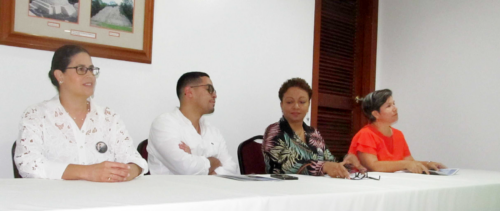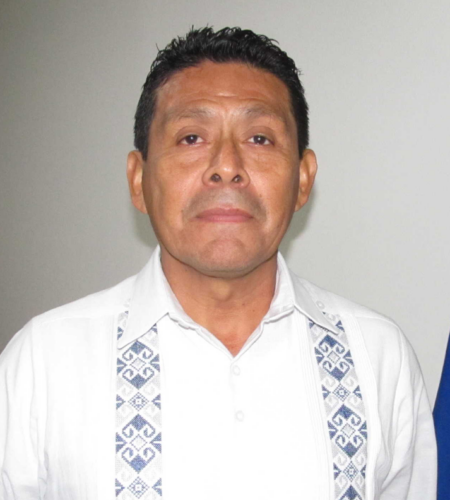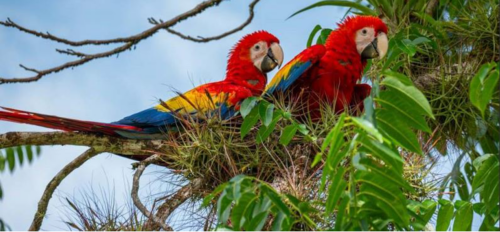

Photo: L-R: Esther Sanchez Sho, FCD’s Programs Director; Rafael Manzanero, FCD’s Executive Director; Hon. John Briceno, Prime Minister of Belize
by Orlando Pulido
SANTA ELENA TOWN, Cayo District, Sun. Dec. 8, 2024
The Friends for Conservation and Development (FCD) held its Annual General Meeting this past Saturday, December 7 at the San Ignacio Resort Hotel. It was an opportunity for all to get together in a team effort at FCD.
FCD is a nonprofit organization that co-manages the Chiquibul National Park (CNP) and provides support to the Forestry Department in its monitoring operations in the Vaca Forest Reserve and the Baldy Beacon Hills of the Mountain Pine Ridge. The CNP is the largest terrestrial protected area in Belize.
At the AGM on Saturday, new members of the board of directors at FCD were nominated and appointed. These were Hector Guerra, an attorney-at-law; Dianne Miranda from Chamberlain Consulting; and Greg Maheia, Atlantic Bank manager.

Photo: L-R: Susana Vanzie, FCD’s board president; Hector Guerra, Director; Tanya Santos Neal, Treasurer; Dr. Elma Kay, current vice president; all members of the Board at FCD
Keynote speaker for the occasion was the Honorable John Briceño, Prime Minister of Belize.

Photo: Prime Minister Hon. John Briceño, giving the keynote address
“I have watched this organization grow from an acorn to a strong tree,” said Prime Minister Briceño. “It has been a collaboration, you could say, for 25 years. When Rafael [Manzanero] just started out in 2000, he came to see me in the office with his ideas. Since then, we have been working closely together. In 2006, we signed the first co-management agreement, which he then took over physically in 2007. So, all along these years, I think it is one of the most heartwarming and fulfilling accomplishments, working along with FCD. Here we are, 25 years later, celebrating,” the Prime Minister told Amandala.

Photo: Rafael Manzanero, the current Executive Director of FCD
Rafael Manzanero, Executive Officer at FCD, reported that over 90 institutions had assisted the organization this year. Luceli Itza, FCD’s finance manager, confirmed that there were $1,897,161.89 in grants for the 2023-to-2024 time period.
As one of Belize’s protected areas, the Chiquibul National Park is rich in biodiversity. The BERDS (Biodiversity and Environmental Resource Data System of Belize) database contains 1,800 plant records from the Chiquibul Forest comprising 662 species as of August 2012. In the Chiquibul there are 1,352 vascular plants, 318 species of trees, 246 species of shrubs, 452 species of herbs, 109 orchid species, 182 species of vines, 20 palms, 4 cacti, 3 cycads, 107 species of ferns, 14 woody parasites and 10 lycopods.
Board member of FCD, Dr. Elma Kay has quantified the value of this national park:

Photo: Studies indicate that approximately 350 individual scarlet macaws are found in Belize
“[The Chiquibul National Park] has been incredibly rich in biodiversity, in the diversity of ecosystems, in terms of what we call ecosystems that it provides. For example, its watershed value—I mean, that forest is so unique; it is the headwaters of our Belize River, which are located within that forest. We still know that a lot of genetic diversity is because wildlife populations are resilient, and the wildlife populations, especially the wide-ranging mammals, need big spaces. So, the Chiquibul is one of those perfect examples of a big forest that provides for those wildlife populations an excellent genetic pool. I think it is a treasure for the entire country. And also, without the Chiquibul, it is not just about biodiversity, but that national security element,” Dr. Kay said.
This year, FCD clearly can report that cattle ranching remains the key threat to the habitat and ecosystems in the Chiquibul. Although the area of impact is well-documented and recognized, efforts at deterrence have had only limited impact. Seven targeted operations to destroy cattle fences and other infrastructure were conducted. These operations were done jointly with the Belize Defence Force due to the proximity to Guatemala. A resurgence of illegal logging has started to be felt, however, in the Caracol Archaeological Reserve and the Chiquibul National Park, particularly in the southern Rio Blanco region. Near that same area, a dirt road was opened by Guatemalans inside the park limits to enable them to have easier access to water for cattle pastures. This triggered an increase in patrols and deployment of manpower in southern Chiquibul. Gold panning also continues to occur 8 kilometers within the CNP boundary, located at the foothills of the Maya Mountains.
As for the 2024 Scarlet Macaw nesting season, a total of 21 active nests were systematically monitored along the Macal and Raspaculo Rivers. Of these, a total of 11 Scarlet Macaw nests (52.38%) produced natural fledglings; a total of 5 nests (23.81%) did not produce any naturally occurring fledging because chicks were extracted to be hand-reared at the Las Cuevas Research In-Situ Laboratory, while 5 other nests (23.81%) had natural nest failure. Studies indicate that approximately 350 individual scarlet macaws are found in Belize. Macaws are threatened in the Eastern Maya Mountains due to habitat alteration and poaching.
Annually, by October macaws fly from the high-elevation region of Chiquibul to the low-elevation eastern Maya Mountain foothills, and especially Red Bank. The Red Bank area now remains the most important feeding ground for the Scarlet Macaws, where they feast on polewood and coffee trees. By March, the red feathered birds return to the Chiquibul.
As Susana Vanzie, FCD’s board president, indicated on Saturday, “‘We look forward to the next 25 years.” The Chiquibul National Park remains a source of viable freshwater and oxygen-production.




